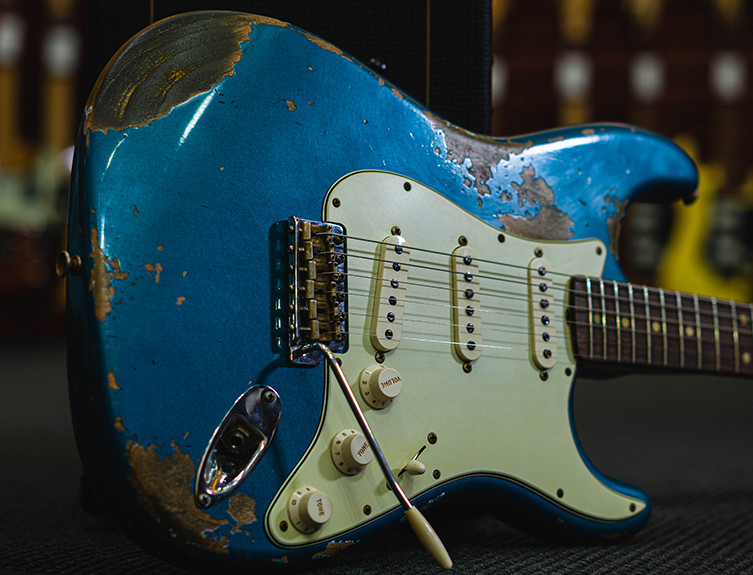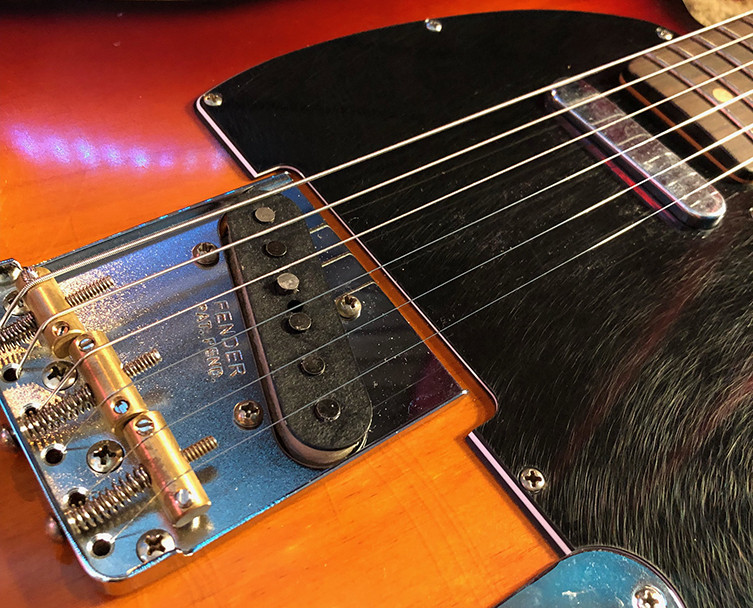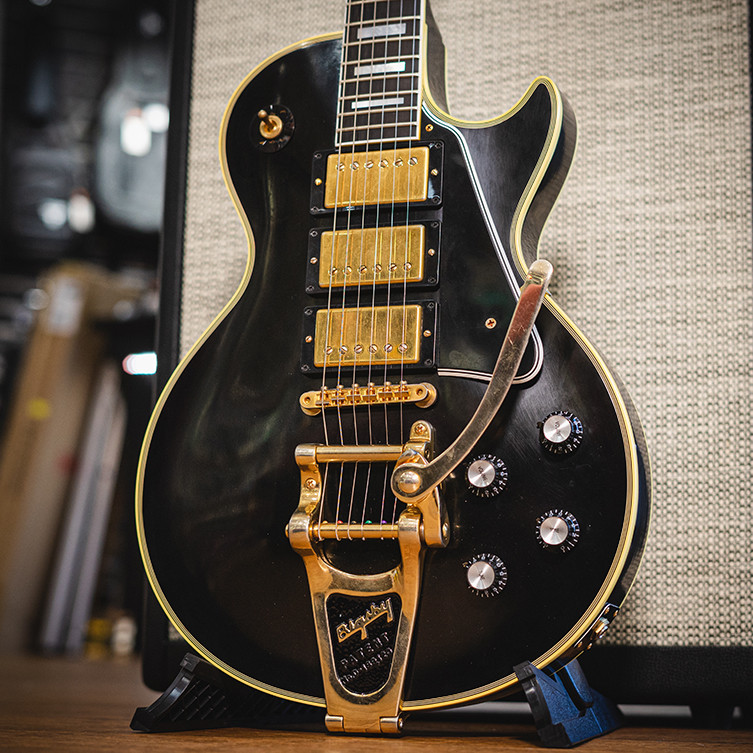Are you curious about the magic behind your guitar’s sound? At guitarplayers.net, we’ll demystify the role of guitar pickups and explore how they shape the sonic landscape of your electric guitar, helping guitar players of all levels understand their instrument better. From single coils to humbuckers, we’ll cover all the essential information. Join us on this electrifying journey of sonic discovery, enhancing your understanding of guitar technology.
1. What Exactly Is a Guitar Pickup?
A guitar pickup is a transducer, converting the mechanical energy of vibrating guitar strings into an electrical signal. This signal is then amplified to produce the sound you hear. Think of it as the microphone for your electric guitar, capturing the nuances of your playing and transmitting them to your amplifier, a fundamental aspect for any guitar player.
1.1. Breaking Down the Components of a Pickup
A typical guitar pickup comprises magnets and copper wire. The magnets create a magnetic field, and the copper wire, wound around the magnets, acts as an inductor. When a steel guitar string vibrates within this magnetic field, it disrupts the field, generating an electrical current in the wire. The specifics of the magnets and wire influence the pickup’s tonal characteristics.
1.2. The Role of Pole Pieces
Pole pieces are the magnetic cores (often adjustable screws or rods) that focus the magnetic field. Their proximity to the strings significantly affects the pickup’s sensitivity and tonal balance. Adjustable pole pieces allow for fine-tuning the output of individual strings, helping you achieve a balanced sound across the fretboard.
1.3. Seth Lover’s Insight on Pickups
Seth Lover, a pioneer in pickup design, offers a unique perspective. He explains that the magnetic field from the pickup magnetizes the strings. The vibration of these magnetized strings within the pickup’s magnetic field induces a voltage in the coil, which is then amplified, shaping the final sound. Lover emphasizes the interaction between the magnetic field and the strings in producing the electrical signal.
"...the magnetic field comes up to the strings there and magnetises the strings. That’s one of the things that most people don’t understand. They figure that string is waving there and cutting the magnetic lines of force. Nuts. That isn’t it. The magnet, all it does is magnetise the string. Now you’ve got a waving magnetic field. And we have a fixed coil with a waving magnetic field to induce voltage. If you want to, take the magnet out. Once you’ve magnetised your strings, it will play until the string loses it. Players think the string, the magnetic field from the magnet, comes up to the string and by twisting the magnetic flux back and forth that’s what induces the voltage. That’s not what happens." *(Seth Lover, from a 1978 interview with Seymour Duncan)*1.4. Different Magnet Types and Their Influence on Tone
Different magnet types alter the pickup’s sound. Alnico magnets, made from aluminum, nickel, and cobalt, are categorized into grades like Alnico II, IV, and V. Alnico II magnets provide a warmer, softer tone, while Alnico V magnets offer a brighter, punchier sound. Ceramic magnets, often used in high-output pickups, deliver a more aggressive, modern tone.
1.5. Single Coil vs. Humbucker Designs: A Quick Comparison
Single-coil pickups, known for their bright and clear sound, are more susceptible to noise and hum. Humbuckers, featuring two coils wired in series, cancel out much of this noise while delivering a thicker, warmer tone. The choice between single coils and humbuckers often depends on the desired musical style and playing environment.
 Fender Stratocaster Single Coil Pickups
Fender Stratocaster Single Coil Pickups
Alt: Fender Stratocaster relic with single-coil pickups, showcasing aged white finish, maple neck, and classic Strat tone for versatile guitar sounds.
2. What Are the Main Types of Guitar Pickups Available?
Guitar pickups come in several varieties, each offering unique tonal characteristics. Understanding these types allows guitarists to select the pickups that best suit their playing style and musical preferences. Here’s an overview of the primary types:
2.1. Single-Coil Pickups: Brightness and Clarity
Single-coil pickups are renowned for their bright, clear, and articulate tone. They excel in delivering crisp highs and a tight low end, making them ideal for genres like country, blues, and pop. However, they are also prone to picking up unwanted hum and noise, especially at higher gain levels.
2.1.1. The Fender Stratocaster Sound
The Fender Stratocaster is synonymous with the single-coil sound. Its pickups produce a clear, bell-like tone that has defined countless classic recordings. Artists like Jimi Hendrix and Eric Clapton have showcased the Stratocaster’s versatility and iconic sound.
2.1.2. The Fender Telecaster Sound
The Fender Telecaster, another iconic guitar, features single-coil pickups with a slightly more muscular tone than the Stratocaster. The Telecaster’s bridge pickup is mounted on a metal plate, contributing to its bright attack and strong sustain. Its unique sound has made it a staple in country, rock, and blues music.
 Fender Telecaster Guitar
Fender Telecaster Guitar
Alt: Classic Fender Telecaster with blonde finish and black pickguard, highlighting its single-coil pickups for a bright and twangy guitar sound, perfect for country and rock.
2.1.3. Lipstick Tube Pickups: Jangle and Twang
Lipstick tube pickups, commonly found on vintage Danelectro and Silvertone guitars, produce a bright, jangly tone. These pickups have a distinct character, making them suitable for surf rock, indie, and retro styles.
2.2. P90 Pickups: A Blend of Single-Coil and Humbucker Tones
P90 pickups, introduced by Gibson in 1946, offer a middle ground between single-coil and humbucker tones. They provide a warm, thick sound with plenty of bite and sustain. P90s are often used in genres like blues, rock, and punk.
2.2.1. The Gibson Les Paul and P90s
The combination of a Gibson Les Paul with P90 pickups has produced some of the most beloved guitar sounds in history. David Gilmour’s use of a vintage Goldtop Les Paul with P90s on “Another Brick in the Wall Part 2” is a prime example of the pickup’s versatile tone.
2.2.2. Addressing the Hum Issue
One drawback of P90s is their susceptibility to hum. However, noise gate pedals, noiseless P90 pickups, and proper shielding can help mitigate this issue.
 Gibson Les Paul with P90 Pickups
Gibson Les Paul with P90 Pickups
Alt: Gibson Les Paul Goldtop with P90 pickups, showcasing its vintage design and warm, powerful tone for classic rock and blues, a staple for guitar players.
2.3. Jazzmaster Pickups: Unique and Versatile
Jazzmaster pickups are often mistaken for P90s, but they have distinct characteristics. They are larger, with wider coils and lower output, resulting in a brighter, more sparkling tone similar to Strat and Tele pickups. Jazzmaster pickups are versatile and can be used in various genres, from indie rock to surf.
2.4. Humbucker Pickups: Warmth and Power
Humbucker pickups, designed to eliminate hum, deliver a thick, warm, and powerful tone. They consist of two coils wired in series, which cancels out noise and increases output. Humbuckers are commonly used in rock, metal, and jazz.
2.4.1. The Design and Function of Humbuckers
Humbuckers use two coils with opposing magnetic polarities to cancel out hum. They can be wired in series or parallel, with series wiring providing a stronger signal.
2.4.2. Open Coil vs. Covered Humbuckers
Open-coil humbuckers have exposed coils and pole pieces, while covered humbuckers have metal or plastic covers. Some players believe that open-coil humbuckers offer extra treble content, though this is subjective.
2.4.3. The Gibson PAF Pickup
The Gibson PAF (Patent Applied For) pickup, designed by Seth Lover in 1955, is considered the pinnacle of humbucker tone. PAF pickups use Alnico II magnets and have relatively low windings, resulting in a big, warm, and sustaining tone suitable for many music styles.
 Gibson Les Paul Custom with Humbucker Pickups
Gibson Les Paul Custom with Humbucker Pickups
Alt: Gibson Les Paul Custom, showcasing its elegant design and powerful humbucker pickups, perfect for rock and blues guitarists seeking rich, sustaining tones.
2.4.4. Fender Wide Range Humbuckers
Fender’s Wide Range humbuckers feature magnetized pole pieces and more windings, retaining much of the signature Fender tone while bucking the hum. These pickups are physically larger and have a unique sound that sets them apart from standard humbuckers.
2.5. High-Output Humbuckers: For Aggressive Tones
High-output humbuckers, popularized in the mid-1970s, deliver a louder, more distorted sound. They achieve higher output through increased windings and the use of ceramic magnets.
2.6. Active Humbuckers: Power and Precision
Active humbuckers use an external power source, typically a 9V battery, to provide an enormous amount of output while keeping noise levels low. Brands like EMG are well-known for their active pickups, favored by metal and shred players.
2.7. Split-Coil P-Bass Pickups: Bass Excellence
Split-coil P-bass pickups, found on Precision basses, feature two coils wired out of phase to eliminate hum and warm up the sound. These pickups are a staple in bass guitar, providing a solid, punchy tone.
2.8. Coil Taps and Coil Splits: Expanding Versatility
Coil taps and coil splits are features that allow guitarists to change the sound of humbucker pickups. A coil split cuts the signal from one coil, effectively making it a single-coil pickup. A coil tap halves the power of the humbucker, resulting in a weaker signal.
2.9. Hand-Wound and Scatter-Wound Pickups: The Boutique Difference
Hand-wound and scatter-wound pickups are made by small companies, offering a boutique alternative to mass-produced pickups. Scatter-wound pickups have inconsistent windings, which some believe enhances the treble response.
 Handwound Humbucker Guitar Pickups
Handwound Humbucker Guitar Pickups
Alt: Pair of handwound humbucker guitar pickups, close-up showcasing detailed craftsmanship and custom design for superior guitar tone and performance.
2.10. Piezo Pickups: Acoustic Amplification
Piezo pickups use quartz crystals to convert the energy of string vibrations into an electrical signal. They are commonly found on acoustic instruments and electric guitars with acoustic sounds.
3. What Are Some Factors That Influence a Pickup’s Tone?
Many factors influence a pickup’s tone, including the type of magnet, the number of wire windings, and the materials used in its construction. Understanding these factors allows guitarists to fine-tune their sound and choose pickups that match their desired tonal characteristics.
3.1. Magnet Type
The magnet type significantly affects the pickup’s tone. Alnico magnets offer a warmer, more vintage tone, while ceramic magnets provide a brighter, more aggressive sound.
3.2. Number of Windings
The number of wire windings around the magnet also influences the pickup’s tone. More windings generally result in a higher output and a thicker, more compressed sound. Fewer windings offer a lower output and a more open, dynamic tone.
3.3. Wire Gauge
The gauge (thickness) of the wire used in the pickup’s coil affects its resistance and inductance, influencing its tone. Thinner wire typically results in a brighter tone with more high-end response, while thicker wire provides a warmer tone with more midrange.
3.4. Pole Piece Material and Design
The material and design of the pole pieces also affect the pickup’s tone. Steel pole pieces offer a brighter, more focused sound, while Alnico pole pieces provide a warmer, more vintage tone. Adjustable pole pieces allow you to fine-tune the output of individual strings, optimizing the overall balance of the pickup.
3.5. Pickup Height
Adjusting the pickup height affects its output and tone. Raising the pickup closer to the strings increases the output and enhances the midrange response. Lowering the pickup decreases the output and creates a more balanced tone.
3.6. Guitar Wood and Construction
The wood used in the guitar’s body and neck, as well as its overall construction, significantly impacts the pickup’s tone. Different woods resonate differently, affecting the frequencies that are emphasized by the pickup. Solid-body guitars tend to have more sustain and a tighter low-end, while semi-hollow and hollow-body guitars offer more resonance and a warmer tone.
4. How Do I Choose the Right Guitar Pickup for My Needs?
Choosing the right guitar pickup involves considering your playing style, the genres of music you play, and the tonal characteristics you desire.
4.1. Identify Your Playing Style
Consider your playing style and the techniques you commonly use. If you play primarily rhythm guitar, a balanced set of pickups with good clarity and articulation may be ideal. If you’re a lead guitarist, you might prefer pickups with higher output and sustain.
4.2. Consider the Genres of Music You Play
The genres of music you play also influence your pickup choice. For blues and classic rock, vintage-style single-coil or humbucker pickups can provide the warmth and character you need. For metal and hard rock, high-output humbuckers or active pickups can deliver the aggression and sustain necessary.
4.3. Define Your Desired Tonal Characteristics
Think about the tonal characteristics you want to achieve. Do you prefer a bright, sparkling tone, or a warm, thick sound? Do you need high output for aggressive playing, or a more moderate output for versatility?
4.4. Research Different Pickup Brands and Models
Research different pickup brands and models to learn about their tonal characteristics and features. Read reviews, watch demo videos, and listen to recordings of guitars equipped with the pickups you’re considering.
4.5. Consider Aftermarket Options
Consider aftermarket options for replacing or upgrading your guitar’s pickups. Many brands specialize in creating custom or vintage-inspired pickups that can significantly improve your guitar’s tone.
4.6. Try Before You Buy
If possible, try out different guitars with the pickups you’re considering before making a purchase. This allows you to hear how the pickups sound in person and determine if they meet your needs.
4.7. Consult with a Guitar Technician or Luthier
Consult with a guitar technician or luthier for personalized advice on choosing the right pickups for your guitar. They can assess your playing style, musical preferences, and guitar’s characteristics to recommend the best options.
5. How to Install a Guitar Pickup
Installing a guitar pickup can enhance your instrument’s sound. Here’s a step-by-step guide to installing a guitar pickup, although it’s often best to consult a professional:
5.1. Gather Tools and Materials
Gather the necessary tools and materials, including a soldering iron, solder, wire cutters, wire strippers, a screwdriver, and a multimeter.
5.2. Remove Old Pickups
Remove the old pickups by desoldering their connections and unscrewing them from the guitar.
5.3. Prepare New Pickups
Prepare the new pickups by soldering the necessary wires to their terminals.
5.4. Install New Pickups
Install the new pickups by screwing them into the guitar and soldering their wires to the appropriate points in the circuit.
5.5. Test and Adjust
Test the new pickups with a multimeter to ensure they are functioning correctly. Adjust their height to achieve the desired output and tone.
6. What Are Common Problems with Guitar Pickups?
Common problems with guitar pickups include noise, weak output, and complete failure. Understanding these issues can help you troubleshoot and maintain your pickups.
6.1. Noise and Hum
Noise and hum are common problems with single-coil pickups. Shielding the guitar’s electronics and using noise gate pedals can reduce these issues.
6.2. Weak Output
Weak output can result from a faulty pickup, a bad solder joint, or incorrect pickup height. Ensure all connections are secure and adjust the pickup height as needed.
6.3. Complete Failure
Complete pickup failure can occur due to a broken coil or damaged components. If a pickup fails completely, it may need to be repaired or replaced.
7. How Can I Maintain My Guitar Pickups?
Maintaining your guitar pickups involves keeping them clean, protecting them from damage, and ensuring proper wiring and connections.
7.1. Keep Pickups Clean
Keep your pickups clean by wiping them down with a soft cloth after each use. Avoid using harsh chemicals or abrasive cleaners.
7.2. Protect from Damage
Protect your pickups from physical damage by storing your guitar in a case when not in use. Avoid dropping or bumping the guitar.
7.3. Check Wiring and Connections
Periodically check the wiring and connections of your pickups to ensure they are secure and free from corrosion. Resolder any loose connections.
8. What Are the Latest Innovations in Guitar Pickup Technology?
Innovations in guitar pickup technology include active pickups with rechargeable batteries, advanced coil-splitting options, and modeling pickups that emulate the sounds of various classic pickups. Fishman’s Fluence systems, for example, offer multiple voices in a single pickup, providing unparalleled versatility.
9. FAQ About Guitar Pickups
Here are some frequently asked questions about guitar pickups:
9.1. What is the difference between active and passive pickups?
Active pickups use an external power source to boost their output and provide a more consistent signal, while passive pickups rely on the guitar’s natural resonance and the player’s technique for their tone.
9.2. How do I adjust the height of my guitar pickups?
Use a screwdriver to adjust the screws on either side of the pickup. Raising the pickup increases output and bass response, while lowering it reduces output and increases clarity.
9.3. What are some popular guitar pickup brands?
Popular guitar pickup brands include Seymour Duncan, DiMarzio, EMG, Fender, and Gibson.
9.4. Can I mix different types of pickups on my guitar?
Yes, many guitarists mix different types of pickups to achieve a versatile range of tones. For example, a Stratocaster might have a humbucker in the bridge position and single-coils in the middle and neck positions.
9.5. What is a coil tap, and what does it do?
A coil tap is a feature that allows you to disable one coil of a humbucker pickup, effectively turning it into a single-coil pickup. This can provide a brighter, more articulate tone.
9.6. How do I know when it’s time to replace my guitar pickups?
You may need to replace your guitar pickups if they sound weak, noisy, or no longer produce the desired tone.
9.7. What is the difference between Alnico and Ceramic magnets?
Alnico magnets are warmer and more vintage-sounding, while ceramic magnets are brighter and more aggressive.
9.8. Can I install guitar pickups myself, or should I take it to a professional?
If you have experience with soldering and electronics, you can install guitar pickups yourself. However, if you are not comfortable with these tasks, it is best to take your guitar to a professional technician or luthier.
9.9. What is shielding, and why is it important?
Shielding is the process of lining the inside of your guitar’s control cavity with conductive material to reduce noise and interference. It is important for achieving a clean and quiet signal.
9.10. What are some tips for choosing the right pickups for my guitar?
Consider your playing style, the genres of music you play, and the tonal characteristics you desire. Research different pickup brands and models, and try out different guitars with the pickups you’re considering before making a purchase.
10. Conclusion: The Impact of Pickups on Your Guitar’s Sound
Guitar pickups are essential components that shape the sound of your electric guitar. Understanding how they work and the different types available allows you to fine-tune your instrument’s tone to match your playing style and musical preferences. Whether you prefer the bright clarity of single-coils or the warm power of humbuckers, the right pickups can significantly enhance your playing experience.
Explore a wide array of guitar lessons, reviews, and a vibrant community of fellow guitar enthusiasts at guitarplayers.net. Discover the perfect resources to elevate your skills and connect with like-minded musicians. Join us today and take your guitar playing to the next level. Visit our website at guitarplayers.net or contact us at Address: 1140 Boylston Street, Boston, MA 02215, United States. Phone: +1 (617) 747-2261 for more information.

